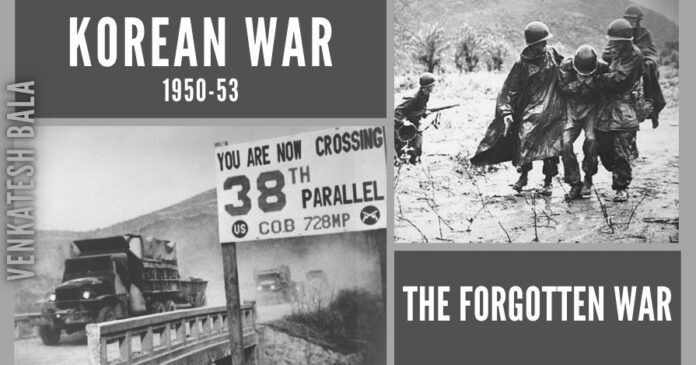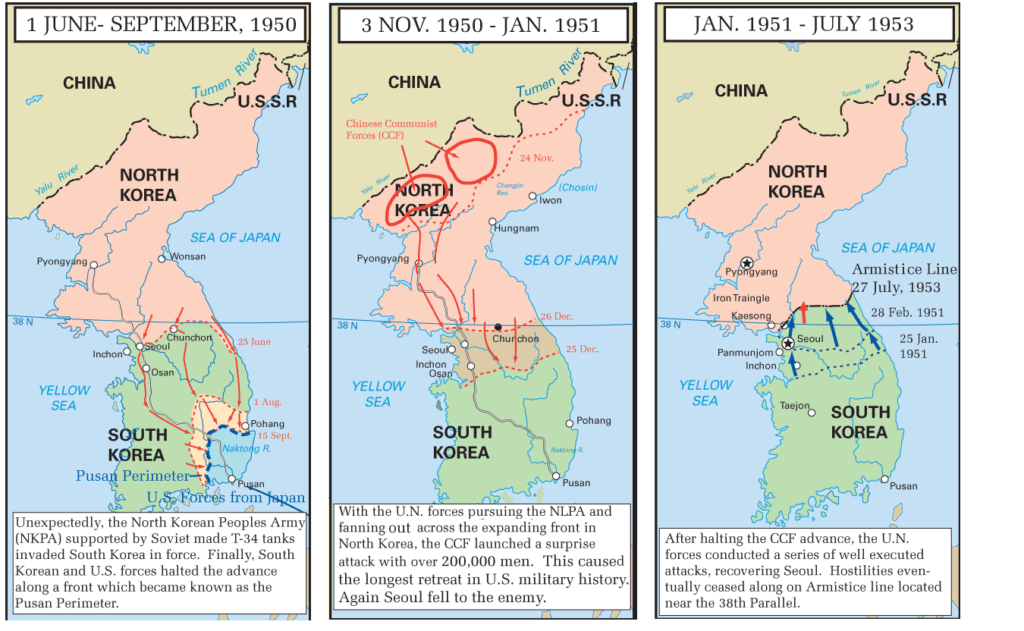
Korean War
In the hot summer of June 1950 in the remote corner of Asia, North Korean Communist forces crossed the 38th Parallel which separates the Communist sphere of North Korea from democratic South Korea, under the Princeton educated autocrat, Syngman Rhee. The South Korean forces buckled under the precise onslaught of highly motivated North Korean soldiers riding astride the Soviet T-34 wide-bodied main tank and American supplied lend-lease equipment from World War II. The highly motivated North Korean Army easily bumped off the ill-fed and ill-equipped South Korean army which scrambled last minutes across the Han river and abandoned their capital Seoul blowing up bridges on the south of Han river filled with civilian refugees fleeing the marauding communist red tide.
Background:
The Korean war lasted for 3 years and pitted the two unlikely adversaries, the United States and Communist China who in turn support their respective clientele satellite states, the Republic of [South] Korea and the Democratic Republic of [North] Korea respectively. The war which resulted in a win, loss, and a tie for combatants over the three years from 1950-53 was due to the fallout of two unlikely bedfellows, Soviet Russia and the democratic United States. The two superpowers came together to defeat Nazi Germany and Imperialist Japan. But the bonhomie of defeating a common enemy was displaced shortly thereafter with suspiciousness, short shortsightedness, dishonesty, and lies after the guns fell silent in Europe and Far East Asia in the summer of 1945. The whole of the Old World and Asia was prostrate having fought themselves to death and saw the end of four great empires (England, France, Germany, and Japan) and the rise of 2 new power centers who were diametrically opposite in their ways of life and government. In the year 1945 at the Crimean sea resort of Yalta Soviet Premier Josef Stalin met with ailing Franklin D. Roosevelt and signed the Yalta accord by which Europe and Asia were to be differentiated into two blocks or spheres of influence. A small unknown peninsula which was under Japanese occupation since the 1900s was to be divided across a man-made 38th parallel separating villages, towns, homes, and families which have been living life together since the times of the Mongol Kublai Khan who ruled Cathy (China) when an unknown Italian visitor Marco Polo was traveling east across the Silk Roads.

As the South Korean government evacuated Seoul, it also appealed to the newly minted world body United Nations for succor and protection from the onslaught from communist North Korean invaders. The UN Security Council voted to protect the South Korean Government against the armed bandit invasion and President Harry Truman of the US didn’t go to the US Congress for declaring war against North Korea and helped defend South Korea. Armed forces of the US which under occupation duties in Japan were thrown piecemeal to stop North Korean invasion forces and found themselves be thrown out of the Pusan perimeter in the Southeastern corner of the Korean peninsula by highly motivated North Korean Armed forces fighting to unite the entire peninsula to form a Marxist Utopian Korea. Under US General Douglas MacArthur, the United Nation forces landed in the back in the port of the city of Inchon in Sept 1950 and managed to cut off the North Korean Communist tide flooding the Southern Korean peninsula and recaptured Seoul in Sept 1950. Gen MacArthur leads President Syngman Rhee back to office and the United Nations forces crossed the 38th parallel beating the North Korean forces in full retreat, captured Pyongyang Yang with the mandate to reunite the entire peninsula under the democratic rule under the autocratic ruler, President Rhee. River Yalu was the natural boundary separating China and North Korea similar to the river Oder and Nesse that separates Poland from Germany. In October 1950, on the first year anniversary of the formation of the Peoples Republic of China, Chinese Premier and Foreign Minister Chou Enlai warned the United Nations forces under the tutelage of Gen MacArthur that if UN forces cross the 38th parallel to reunite Korea, Peoples Republic of China will enter the war on behalf of the North Korean to maintain the buffer state. On Oct 24th, 1950, the Chinese People Liberation (PLA) Army under the nom de guerra of Chinese People’s Volunteers Army (PVA) fought the first major skirmish against ROK (South Korean) forces and the US 8th Army on the Mountainous terrain cross the Chongchon River. The United States Army units and ROK (South Korean) were attacked by a swarm of Chinese Communist forces fighting an asymmetric war as guerrilla units that beat back the US and Army sent the UN/US/ROK forces back in retreat across the Chongchon River in North-Western part of Korea. Then the Chinese backed way after their assault and left everyone in the US Armed forces High Command and UN administration pondering what really happened. This was the first of five impulses of the Chinese PLA/ CCF/ PVA. The UN forces made the strategic blunder of split into two portions, the 8th Army in the West and the 10th Army in the Eastern part of North Korea on their drive north to Yalu River and reunite Korea under Rhee’s form of government. When Gen MacArthur was warned that UN troops had encountered and captured a few of the well-armed Chinese fighters in padded winter clothes totting American made Lend-lease guns, mortars, and assault weapons and were in fact units from PLA and not the North Korean regular army, the General is said to remark: “Aren’t there Mexicans in Texas?”
General MacArthur had promised President Truman in the Wake island in late fall of 1950 promising that the US troops would be home by Christmas 1950.
Chinese Intervention: The Game Changer
Nearly a month later in November 1950, after Thanksgiving Day, the Chinese PLA/ CCF/ PVA boiled out of their jump-off position and slammed into the 8th Army inward flank on the Western sector and 10th Corp in the East sector of the UN/ US/ ROK forces in Northern Korea. The Chinese used the heavy formation of troops approximately 400,000 (approximately equivalent to four 4 field armies equivalent to 40 divisions) against the United Nations/ United States Army.
How did the Chinese manage to sneak in about ½ million front-line troops of PLA/ CCF/ PVA across the Yalu River into the North Korean peninsula? Unlike the UN/US forces which were road-bound and had a huge logistical trail, the Chinese troops were highly mobile using their legs to march to the front lines from the Yalu River. They had superb march discipline, especially in the night marches, and had been winners fighting and defeating both the Imperial Japanese Army which in turn had defeated British, French, Dutch, and The Australian and New Zealand Army Corps (ANZAC) forces during WW2 as well as Kuomintang Army of Gen. Chiang Kai-Shek during the Chinese civil war form 1933-49. They were a peasant Army leaned on logistics and strong on infantry and close quarter combat.
How did the Chinese People Volunteers/ PLA defeat the US army in Northern Korea and send them streaming down in retreat below the 38th parallel?
The UN/US forces were road-bound and relied on the Main Supply Routes (MSR) which are mountain roads servicing the isolated pockets and towns in Northern Korea where the US 8th Army and 10th Corp (Eastern sector). The Chinese CCF/ PVA had a four-step process:
- Infiltration
- Setting up roadblocks
- Launch Massive frontal assaults
- Chewing up isolated UN/ US units piecemeal and moving on to the next target on the front line.
- Using a ratio of 5:2 or in some case 4:1, Chinese forces simply overwhelmed the tired and road-bound UN/US forces under strain under winter weather conditions. Wind Speed of 50 mph and temperature of minus 40 below Zero negative Celsius.
Chinese were strong guerrilla infantry units, highly mobile, masters of camouflage, and night fighting, they were not road-bound. Although the skies and water around the Korean peninsula were dominated by the US/ UN air and naval forces, the PLA was land animal that sent the US/ UN/ ROK forces back across the 38th parallel and recaptured the South Korean capital of Seoul in Feb 1951 in their third phase of winter offensives.
Battle of Chosin Reservoir (Nov 1950)
One Marine Corp (about 23000 troops) under Gen. Oliver P. Smith against 280,000 CCF forces (28 divisions equivalent). When the Chinese troops attached the UN/US/ROK troops during their second impulse in Nov 1950, a small detachment of Marine Corp was littered around the Northeastern Korean peninsula around the region of the Chosin reservoir. When Chinese CCF forces launched their winter offensive, their met their match against a highly cohesive, determined Marine Corp led by General O P Smith looked at the map of Korea, the MSR, and the hills surrounded by peaks and valleys with its fast-flowing trestles and river in summer month which froze solid under the Siberian winds and Arctic conditions of -40 below temperature and howling winds across Manchurian and Siberia. The Chinese CCF/PVA could not defeat the Marine division in Kotori, Hagarori, and base camp at Yudamni. Although the distance was about 50 miles as the crow flies, the highly mountainous terrain and heights were held by the Chinese which poured firepower on the MSR-bound convoys and columns that were retreating down the Korean peninsula. The US Marine Corps cleared the heights and ridgelines of Chinese CCF/PVA and signaled the movement of retreating marines which brought back their dead, flown out they’re wounded using C-47 Aircraft which on a hard-worn out airstrip on the Chosin peninsula. After 14 days of an epic battle against inhumane weather conditions, having slept for hardly a few hours, the Marines reached the port city of Wusan for an Asiatic Dunkirk-style evacuation from Northern Korea. They brought home their men (both live and dead), and their field equipment and fought a heroic battle against a highly motivated and determined enemy. The Chinese did not disturb the retreating Marine Corp soldiers. When asked by the press reporters that the Marine Corp was pulling out from their base in Hagarori to Wusan for evacuation, Gen Smith is said to have remarked. “Retreat! Hell, we are just attacking in another direction.”
In the month of April 1951 after a series of military defeats on the front line and insubordination, Gen MacArthur was fired by President Truman and replaced by an able and daring commander from 101st Air Borne Division, Gen. Matthew Ridgeway who in turn brought Gen. Van Fleet was able to wrestle Seoul back from the Chinese at a very high cost.
The next part of the set-piece battle was the Chinese initiative to push to recapture Seoul and drive the UN/ US off the Korean peninsula. This started on April 22nd which was the fourth offensive (impulse) wherein the Chinese Army Commander Lin Biao promised to celebrate International Workers day popularly known as the May Day in Seoul by promising it to recapture for Communist North Korea. The UN/US/ROK troops had learned their lessons of asymmetric nature from the winter warfare from Nov 1950 – May 1951 which used guerrilla tactics of Chinese CCF/PLA/PVF and a lot of abandoned material (from US forces during their forced retreat) is prepared to meet them with well-entrenched defensive lines called Kansas, Utah, Wyoming just below the 38th parallel with the “Van Fleet Load.” The philosophy of the US Generals was to fall back into the known defensible position (named after US state lines) when the Chinese assault started and use their immense firepower from both Artillery and Air Force to repeal to blunt and deflect their CCF/PLA/PVA thrusts into ROK/ UN/ US strong point defensive. The end result was the Chinese were able to capture a few miles of South Korean territory South of the 38th parallel at tremendous losses (approximately 300,000 dead) and the US/ US/ ROK stayed at their defensive positions and stopped the Communist offensives cold in front of the Imjim River North of Seoul.
In May 1951 the Chinese launched their fifth and final impulse (part II of their Spring Offensive) in the Eastern part of the Korean peninsula across the mountainous terrain where the UN forces and ROK forces used mobile units as opposed to units supplied by MSR (main supply routes across the mountains back of Korean peninsula.) The US army had learned the lessons and had combat teams that weren’t road-bound and could be airdropped using helicopters both rescue and
Both Chinese PVA/CCF and US/UN forces wanted to fight their war as cheaply as possible. And what they considered cheap could not be more was diametrically opposites. Chinese Peoples Volunteers Army/CCF was heavy on using infantry formation (manpower) with little or no tactical air support with an ancient logistics system that relied on mules, donkeys and human A-frame for their supply chain Whereas the highly technological advanced US/ UN/ ROK army were material rich and had an overabundance of air, naval and artillery firepower, communication, and food supplies. But such advancements made their men dependent on technology rather than human capital which Chinese with political commissars had both depth training on tactical and strategic depth to carry out the war. While the former could bleed their men, the latter could bleed their steel but neither could defeat each other for the next 2 years when the Korean War ground killing about ½ million UN forces soldiers, 1.5 Million Chinese, and North Korean plus two-three million civilians until July 1953.
Lessons learned from the Chinese Intervention in the Korean War for the Indian Army guarding the areas of Ladhak and the Eastern hills of Arunachal Pradesh bordering Tibet.
- Do not be road bound to Main Supply Routes. Create defensive fallback positions with strength them adequately with the supply depot.
- Maintain airstrips to help prepare land transport air crafts to land supplies and take back the wounded for treatment.
- Capture the ridgelines of mountain terrain as height is very crucial for providing accurate artillery fire. (Ask any Indo-Pak veteran from the 1999 Kargil War and 1986 Siachen).
- Reliance on technology (night vision goggles, perimeter fences) and tactical air support at the Himalayas with laser infrared-guided precision munition at higher altitudes.
- Always remember that the Odds are always on the cheaper man. Having less helps ease supply chain constraints of the tortuous supply route from the plains of Punjab up the Jammu & Kashmir valley via Kargil, Ladhak into Eastern frontiers of Gosthana.
Note:
1. Text in Blue points to additional data on the topic.
2. The views expressed here are those of the author and do not necessarily represent or reflect the views of PGurus.
PGurus is now on Telegram. Click here to join our channel and stay updated with all the latest news and views
For all the latest updates, download PGurus App.
- Korean War: The forgotten war - October 25, 2020








